The Cevennes, southern France
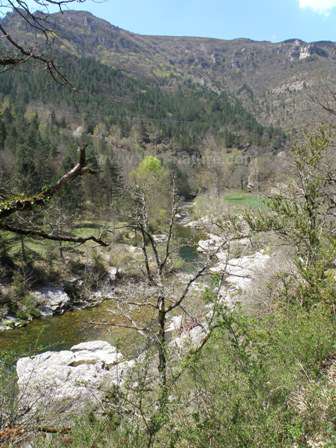
The Cévennes National Park - Parc National des Cévennes - is situated in an area of outstanding natural beauty in the south of France. Created in 1970, the park covers parts of four 'departments' in France; Lozere, Gard, Ardeche and Aveyron. It's administrative office is located in the small town of Florac.
A well known destination for hiking, canoeing and other outdoor activities, the Cevennes National Park is also a naturalist's paradise with an abundance of wildlife to see and enjoy. From April onwards wildflowers carpet the pastures and roadside verges in the valleys, and later in the season, the vast limestone grasslands of the high Causse Plateaux become the focus of those interested in botany. These high Causse plateaux are vast areas of limestone through which rivers have cut the famous Cevennes deep valleys and gorges of which the best known is probably the Tarn Gorge.The flowers that thrive in the special conditions there make the area an ideal habitat for butterflies, moths and other insects in search of nectar or pollen.
The Park is also famous for its birdlife, in particular it's numerous species of birds of prey. Twenty-seven have been recorded there and include Short-toed Eagles and three species of vultures, Egyptian, Griffon and Cinereous.
The Causse plateaux are not just exceptional places to see wildflowers and wild orchids they are also home to a large number of other rare birds including Stone Curlew, Ortolan Bunting, Red-backed Shrike, Little Owl, Hen Harrier, Montagu’s Harrier, Hoopoe, Nightjar and Rock Thrush.
The warming and lengthening days of late April bring the early wildflowers out and it is not long before the roadside banks of the Cevennes valleys are covered in Cowslips - Primula veris, and in some places, Primroses - Primula vulgaris, too. Along with these are large clumps of Stinking Hellebore - Helleborus foetidus, interspersed with flashes of deep blue Lungwort - Pulmonaria officinalis, a lovely plant whose flowers first appear as deep pink buds, turning a vibrant blue once they open fully.
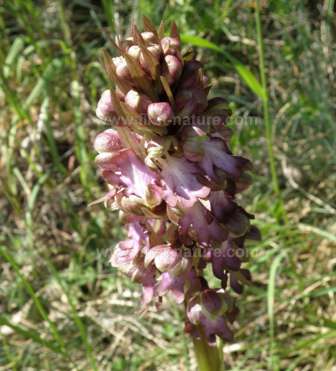
The Cevennes National Park is famous for its wild orchids and the first to appear there are Small Spider Orchid - Ophrys areneola, Ophrys passionis and the fabulous Giant Orchid - Himantoglossum robertianum. This massive plant is more often associated with the Mediterranean countries and is well known from Greece and the Greek islands, especially Rhodes where it grows in old olive groves and flowers as early as February. In the Cevennes it can be found in roadside ditches and pastures and flowers towards the end of April and into May. As the spring and summer progress it becomes clear why the Cevennes is such a mecca for those interested in wild orchids: both the yellow and red Elder-flowered Orchids - Dactylorhiza sambucina carpet the ground in some spots, and other species include Military Orchid - Orchis militaris, Lady Orchid - Orchis purpurea, Monkey Orchid - Orchis simia, Early Purple Orchid - Orchis mascula, Green-winged Orchid - Anacamptis morio, Common Spotted-orchid - Dactylorhiza fuchsii, Greater Butterfly Orchid - Platanthera chlorantha and Bird's-nest Orchid - Neottia nidus-avis. Both Sword-leaved Helleborine - Cephalanthera longifolia and its close relative Cephalanthera damasonium occur in the Cevennes as do two more very special and rare plants: Lady's Slipper-orchid - Cypripedium calceolus and the endemic Aymonins Fly Orchid - Ophrys aymoninii.
The Cevennes is a very special place for butterflies and visitors during April, May and June can expect to see many exciting species including Berger’s Clouded Yellow, Common Clouded Yellow, Adonis, Turquoise Blue, Small Heath, Pearly Heath, Heath Fritillary and the rare Esper’s Marbled White. In all around 80 species of butterflies have been recorded in the area.
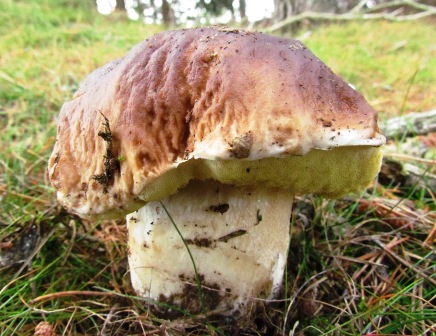
In autumn the Cevennes National Park becomes a paradise for those interested in fungi. Apart from the renowned autumn editble species such as Ceps and Chanterelles, the diversity of the trees found throughout the area is reflected in the immense variety of mushroom species found in the park. The picking of the prize edible species is strictly controlled in some areas, but there is still plenty of places for the amateur fungi gourment to chance upon the wherewithal to enhance his supper with a special treat.
There are some wonderful Beech woodlands in the park and they are an excellent place to start looking for mushrooms: not only are they home to Ceps, you are likely to come across Fly Agaric, Parasol, Deceiver, Milkcaps, Beechwood Sickener and other Brittlegills inlcuding Ochre Brittlegill.
On the High Causse there are vast tracts of conifer forests, and these have their own specialities including the rare Violet Webcap. Other sepcies you could expect to find there include Amethyst Deceiver, False Deathcap.
Notes on Accommodation in the Cevennes National Park
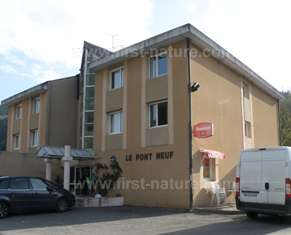
Le Pont Neuf Hotel, Florac
We have stayed in Florac, which is home to the Administrative Office for the Cevennes National Park. If you go there you need to park outside the town if possible as there very little parking available in the centre. There are a number of hotels in the town, but these are again hampered by difficulties with parking. By far the best place to stay is the Hotel Pont Neuf which is on the roundabout at the sourtherly end of the town. It is only a 2 Star establishment but it is a friendly family-run business where the rooms are spotlessly clean and the restaurant serves a stupendous four course dinner in the evening which, accompanied by some of the local wine, comes in at around 20 Euros per head (2014 prices). It is ideally suited for driving into various parts of the park each day.
We have also stayed in self-catering establishements in the village of Chamborigaud which is a lovely, unspoilt village also ideal for getting into the park on a daily basis. It has a small supermarket, a Boulangerie which is literally open all hours, and several restaurants serving local food and wine.
There are many other places throughout the park where you can stay, but many are closed except during the main season when they are packed to the doors making booking essential.
Find and Identify Wild Orchids in the Cevennes National Park
For more information on each of the species listed below click on the links from the scientific names.
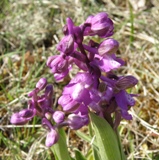 |
Anacamptis morio - Green-winged Orchid Increasingly threatened in the UK and other parts of northern Europe, this orchid still flourishes on the High Causse in the Cevennes and carpets the ground in favoured spots from mid-to-late April and into May. |
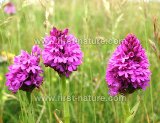 |
Anacamptis pyramidalis - Pyramidal Orchid A common orchid in the Cevennes but very beautiful nonetheless. It is a lovely deep pink in colour and the flowerhead is distinctly pyramidal in shape when the flowers first start to open. Later they becomes much more egg-shaped which often fools people into thinking that they have found something other than the Pyramidal Orchid. |
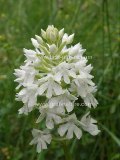 |
Anacamptis pyramidalis var. alba - Pyramidal Orchid - white variant As above but occasionally a pure white form will appear among the pink flowers. |
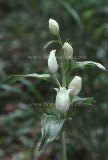 |
This species can be difficult to distinguish from Cepalanthera longifolia and it grows in the same types of habitats, adding to the confusion. The Cevennes region of France has plenty of its preferred habitat of chalk-based beechwoods. It flowers from May and into June. |
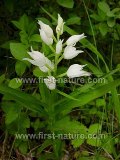 |
Cephalanthera longifolia - Sword-leaved Helleborine The list of orchids found in the Cevennes truly is a litany of species which are now very rare in northern Europe and the UK, and this species is not exception. It is a woodland plant and can be found in open woodland rides in late April and early May. |
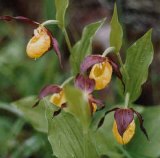 |
Cypripedium calceolus - Lady's Slipper Orchid This is probably the most sought after orchid in Europe and one that all those interested in wild orchids would love to see in the wild. It is rare and threatened throughout its range as a result of habitat destruction and collecting of plants by unscrupulous individuals. In the Cevennes in flowers in May or June depending on the season, and can be found on Mont Lozere. |
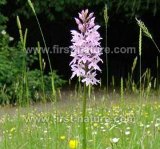 |
Dactylorhiza fuschsii - Common Spotted-orchid Well known from many northern European countries this is a chalk-loving species of orchid which flowers from May and into June. Look out for it in unimproved grassland and meadows. |
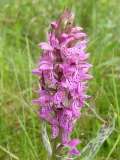 |
Dactylorhiza majalis - Broad-leaved Marsh-orchid The distribution of this marsh orchid is poorly understood due to its confusion with other similar species. It grows in very wet and marshy grassland and flowers in late May and early June. Its broad leaves are heavily marked with large dark spots.
|
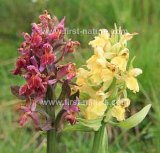 |
Dactylorhiza sambucina - Elder-flowered Orchid This intriguing orchid appears in two colours - dark red and bright yellow and nobody really understands why. It is a grassland species which is in serious decline throughout its range due to habitat destruction. It flowers in late May and June in undisturbed grasslands. Its territory extends from southern Europe and extends into the east and as far north as Scandinavia.
|
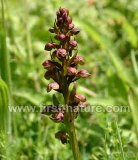 |
Dactylorhiza viridis - Frog Orchid The Frog Orchid is a rare species in the Cevennes region, but it is also very difficult to spot because of it's drab greenish-brown colour which becomes lost among surrounding vegetation. It is tolerant of a wide range of habitats from meadows, open woodland and fens. It flowers from May until well into July. |
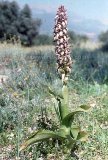 |
Himantoglossum robertianum - Giant Orchid A surprise find for us in early April, it appears that the distribution of this amazing orchid is moving slowly northwards. We saw it in mid April in a roadside ditch just outside Florac. It can grow to over a metre in height and the flowers vary from a dullish green colour to dark pink. Further south it is one of the first orchids to appear and the flowers in the Greek islands appear as early as February. Further north it flowers later but still well ahead of the majority of orchids. |
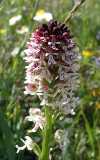 |
Neotinea ustulata - Burnt Orchid A slightly later-flowering species of orchid, the Burnt Orchid (sometimes referred to as Burnt-tip Orchid) grows in grassy areas of the Cevennes and up on the High Causse. Look for it from the beginning-to-end-of May. |
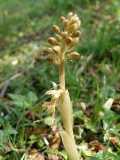 |
Neottia nidus-avis - Bird's-nest Orchid This is an interesting orchid which is entirely lacking in chlorophyll and therefore unable to photosynthesise its own food. It lives in Beech woodland and grows up through the leaf litter making it very difficult to spot. In Wales I have found it under Lime trees, but Beech woods are the best place to look. It establishes a mutually beneficial relationship with micorrhizal fungi from which it gains the necessary nutrients to germinate and grow. It comes into flower from mid May onwards. |
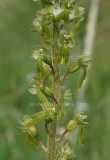 |
Neottia ovata - Common Twayblade Common by name and common by nature the Common Twayblade is a chalk-loving orchid which flowers freely in most of the unimproved grasslands of the Cevennes. Look out for it from May onwards. |
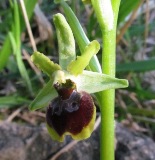 |
This is another very early-flowering species of the early spider orchids. The distribution of Ophrys araneola is centred in France and it grows on alkaline soils in short-sward grasslands, on roadside verges and on the edges of woodland. Look out for this distinctive orchid with the yellow border around the distinctly lobed flower lip from February onwards. |
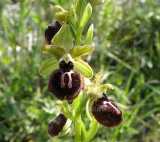 |
Ophrys sphegodes - Early Spider Orchid This orchid appears very early in the year and is rather difficult to spot. It is very rare in the UK and grows on the limestone cliffs of Kent and Dorset where it is probably at the most northerly part of its territory being far more common in the southerly parts of Europe. Look out for it from early April on the side of tracks and paths through open wooded areas.. |
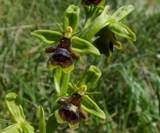 |
Ophrys insectifera subsp. aymoninii - Aymonin's Fly Orchid This orchid is very similar to the Fly Orchid - Ophrys insectifera, but has much more yellow colouring in the flowers. It is both rare and localised and is endemic to the southern Causses in France, where it grows in short grassland, scrub and on woodland edges. It flowers from May to the beginning of July |
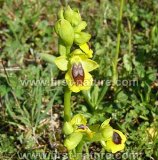 |
Ophrys lutea - Yellow Bee Orchid This delightful orchid is very common in the southern Mediterranean-Atlantic region and is particularly numerous in the Algarve region of Portugal. It's distribution stretches right up into France as far as Charente. It grows on alkaline soils in grassland, scrub and abandoned farmland, in particular. It flowers from March (in the far south) and can be found until June in the more northerly parts of its range. |
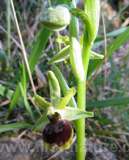 |
Ophrys passionis - Passiontide Ophrys This orchid grows in a lot of different habitats as long as they are calcareous. Ophrys passionis is found in short unimproved grassland, in abandoned farmland, scrub and open woodland. It flowers early from March but can be seen well into June as it is known to have successive waves of flowering. |
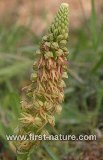 |
Orchis anthropophora - Man Orchid When I first took an interest in wild orchids I wondered if I would ever see this very rare (in Britain) species - and I still haven't seen it there! I have seen in it many southern European countries over the years and it is quite numerous in parts of the Cevennes. It flowers from around mid May and you should look for it in unimproved grassland and up on the High Causse where it can be particularly numerous. |
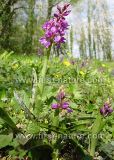 |
Orchis mascula - Early Purple Orchid Usually the first of the wild orchids to appear in the Cevennes, this species grows on grassy banks and in unimproved grassland. It flowers from mid-to-late April. The only species to flower earlier is the Early Spider Orchid - see above. |
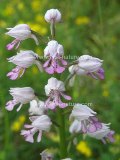 |
Orchis militaris - Military Orchid This orchid is another rare and endangered species in the UK and northern Europe but it still flowers freely on the roadside banks and in unimproved pastures of the Lot Valley. It flowers slightly later than other orchis species and appears from mid May in most years. |
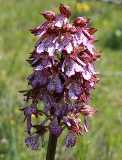 |
Orchis purpurea - Lady Orchid Surely one of the most beaufiful of the orchis species, the Lady Orchid is a threatened or endangered species in the UK and in many other countries of northern Europe. It flowers early in the Cevennes - from the end of April until the end of May - appearing at the same time as the Early Purple Orchids and Green-winged Orchids. Look for it on grassy banks and in unimproved grassland and pastures. |
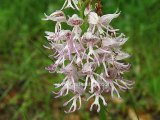 |
Orchis simia - Monkey Orchid The Monkey Orchid is a real speciality of the Lot Valley and the Cevennes (but very rare and scattered in other parts of northern Europe and the UK) where it flowers from the end of April until the end of May. Look for it on roadside verges and in unimproved grassland and meadows. |
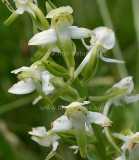 |
Platanthera chlorantha - Greater Butterfly Orchid Both Butterfly orchids appear together in some places and they are notoriously difficult to tell apart particularly as the 'lesser' and 'greater' epithets are no indication of the size of the plants or the flowers at all! It is the pollinia (structure in the flower that holds the pollen) of the flowers that give the game away: in the Lesser Butterfly Orchid they are parallel and in the Greater Butterfly Orchid they form an open upside down V shape. They are truly a woodland species in the Lot Valley and the Cevennes and appear in sunny woodland rides throughout the area. they They normally flower from early May onwards. |